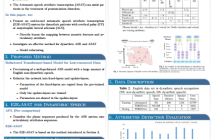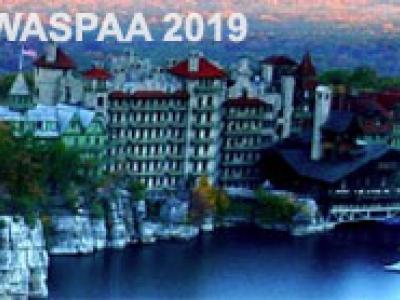- Acoustic Modeling for Automatic Speech Recognition (SPE-RECO)
- General Topics in Speech Recognition (SPE-GASR)
- Large Vocabulary Continuous Recognition/Search (SPE-LVCR)
- Lexical Modeling and Access (SPE-LEXI)
- Multilingual Recognition and Identification (SPE-MULT)
- Resource constrained speech recognition (SPE-RCSR)
- Robust Speech Recognition (SPE-ROBU)
- Speaker Recognition and Characterization (SPE-SPKR)
- Speech Adaptation/Normalization (SPE-ADAP)
- Speech Analysis (SPE-ANLS)
- Speech Coding (SPE-CODI)
- Speech Enhancement (SPE-ENHA)
- Speech Perception and Psychoacoustics (SPE-SPER)
- Speech Production (SPE-SPRD)
- Speech Synthesis and Generation, including TTS (SPE-SYNT)

- Read more about Neural Networks Optimally Compress the Sawbridge
- Log in to post comments
- Categories:
 41 Views
41 Views
- Read more about MULTI-HEAD ATTENTION FOR SPEECH EMOTION RECOGNITION WITH AUXILIARY LEARNING OF GENDER RECOGNITION
- Log in to post comments
The paper presents a Multi-Head Attention deep learning network for Speech Emotion Recognition (SER) using Log mel-Filter Bank Energies (LFBE) spectral features as the input. The multi-head attention along with the position embedding jointly attends to information from different representations of the same LFBE input sequence. The position embedding helps in attending to the dominant emotion features by identifying positions of the features in the sequence. In addition to Multi-Head Attention and position embedding, we apply multi-task learning with gender recognition as an auxiliary task.
ICASSP.pdf
- Categories:
 149 Views
149 Views
- Read more about DEEP ENCODED LINGUISTIC AND ACOUSTIC CUES FOR ATTENTION BASED END TO END SPEECH EMOTION RECOGNITION
- Log in to post comments
- Categories:
 74 Views
74 Views
- Read more about Multi-Conditioning & Data Augmentation using Generative Noise Model for Speech Emotion Recognition in Noisy Conditions
- Log in to post comments
Degradation due to additive noise is a significant road block in the real-life deployment of Speech Emotion Recognition (SER) systems. Most of the previous work in this field dealt with the noise degradation either at the signal or at the feature level. In this paper, to address the robustness aspect of the SER in additive noise scenarios, we propose multi-conditioning and data augmentation using an utterance level parametric generative noise model. The generative noise model is designed to generate noise types which can span the entire noise space in the mel-filterbank energy domain.
- Categories:
 96 Views
96 Views
- Read more about Generating and Protecting Against Adversarial Attacks for Deep Speech-based Emotion Recognition Models
- Log in to post comments
- Categories:
 47 Views
47 Views
- Read more about Defense against adversarial attacks on spoofing countermeasures of ASV
- 1 comment
- Log in to post comments
Various spearheads countermeasure methods for automatic speaker verification (ASV) with considerable performance for anti-spoofing are proposed in ASVspoof 2019 challenge. However, previous work has shown that countermeasure models are subject to adversarial examples indistinguishable from natural data. A good countermeasure model should not only be robust to spoofing audio, including synthetic, converted, and replayed audios, but counter deliberately generated examples by malicious adversaries.
- Categories:
 44 Views
44 Views
- Read more about END-TO-END ARTICULATORY MODELING FOR DYSARTHRIC ARTICULATORY ATTRIBUTE DETECTION
- Log in to post comments
In this study, we focus on detecting articulatory attribute errors for dysarthric patients with cerebral palsy (CP) or amyotrophic lateral sclerosis (ALS). There are two major challenges for this task. The pronunciation of dysarthric patients is unclear and inaccurate, which results in poor performances of traditional automatic speech recognition (ASR) systems and traditional automatic speech attribute transcription (ASAT). In addition, the data is limited because of the difficulty of recording.
- Categories:
 42 Views
42 Views
- Read more about A CLASSIFICATION-AIDED FRAMEWORK FOR NON-INTRUSIVE SPEECH QUALITY ASSESSMENT
- Log in to post comments
Objective metrics, such as the perceptual evaluation of speech quality (PESQ) have become standard measures for evaluating speech. These metrics enable efficient and costless evaluations, where ratings are often computed by comparing a degraded speech signal to its underlying clean reference signal. Reference-based metrics, however, cannot be used to evaluate real-world signals that have inaccessible references. This project develops a nonintrusive framework for evaluating the perceptual quality of noisy and enhanced speech.
WASPAA.v3.pdf
- Categories:
 328 Views
328 Views
- Read more about Speech Landmark Bigrams for Depression Detection from Naturalistic Smartphone Speech
- Log in to post comments
Detection of depression from speech has attracted significant research attention in recent years but remains a challenge, particularly for speech from diverse smartphones in natural environments. This paper proposes two sets of novel features based on speech landmark bigrams associated with abrupt speech articulatory events for depression detection from smartphone audio recordings. Combined with techniques adapted from natural language text processing, the proposed features further exploit landmark bigrams by discovering latent articulatory events.
- Categories:
 92 Views
92 Views
- Read more about Adversarial Speaker Adaptation
- Log in to post comments
We propose a novel adversarial speaker adaptation (ASA) scheme, in which adversarial learning is applied to regularize the distribution of deep hidden features in a speaker-dependent (SD) deep neural network (DNN) acoustic model to be close to that of a fixed speaker-independent (SI) DNN acoustic model during adaptation. An additional discriminator network is introduced to distinguish the deep features generated by the SD model from those produced by the SI model.
- Categories:
 21 Views
21 Views